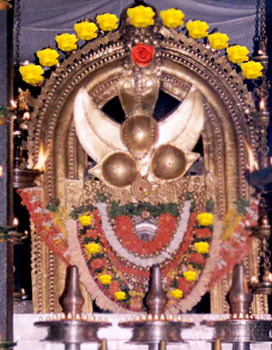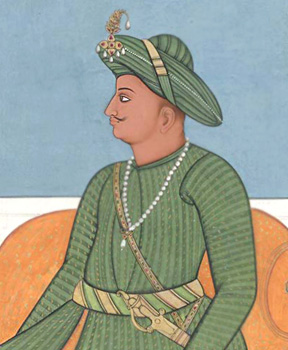 Lord Rama on his return from Lanka after annihilating Ravana and other Rakshasas rested in Taliparamba Temple with his entourage. He offered prayers to Parameswara from the mukhaman-dapa in front of the sanctum sanctorum. Even today no one is allowed into this namaskara mandapa and offer prayers which is permitted in other temples for Brahmins.
Lord Rama on his return from Lanka after annihilating Ravana and other Rakshasas rested in Taliparamba Temple with his entourage. He offered prayers to Parameswara from the mukhaman-dapa in front of the sanctum sanctorum. Even today no one is allowed into this namaskara mandapa and offer prayers which is permitted in other temples for Brahmins.
One of the Zamorins was an ardent devotee of the Lord of Taliparamba. After years of intense worship he is said to have entered the sanctum sanctorum and merged with the God. Even today when the elder Zamorin dies the information should be given to the temple authorities and the Lord is supposed to observe mourning. Even the distant Travancore kings paid obeisance to the deity by offering an elephant whenever a ruler is crowned or visited the temple.
Taliparamba was formerly known as Perinjellur or Lakshmipuram in Sanskrit. This was one of the sixty-four gramams or villages in Kerala. There were sixty-four Nambudiri families in this village who were the uralarjs or temple trustees. The administration of Taliparamba was conducted on behalf of the Lord of the temple of Taliatiri elected from those Nambudiris. Taliatiri enjoyed enormous powers which he was expected to use for the protection of the people and also for the punishment of the evil-doers.
The Pride of Brahmins
According to Kerala Mahatmya, it was Bargavarama who brought 15,000 brahmins from Ahichatram and settled them at Taliparamba. Mayura Varma, one of the Kolattiris (as the rulers of Kolathunad were called) built the village for these Brahmins and endowed them with properties to enable them to lead a life of piety and learning. Indeed there was no village in Kerala to equal Taliparamba in respect of learning, devotion etc.
Shiva Yogi
Among those who contributed to the prosperity of the village and the temple, the foremost was Shivangal. He was also known as Shiva Yogi or Atyasrami though his real name was Raghavananda. At the time of King Ravi Varma Kulasekhara (1299-1314) of Venad, himself a great scholar, Shivangal shone like a bright star in North Kerala. He was born in Vallavu Village, about 3 km. to the north of Taliparamba temple and there is still a matham, called Shiva Yogi matham, on the south side of the temple, where Shiva Yogi lived.
 He learnt the Vedas, Mimamsa, mantra and tantra and took sanyas at a very early age. Like Vilwamanga lathu Swamiyar (Leelasukan), he was a great devotee of Shiva. Hence he came to be known as Shiva Yogi. The Lord of Taliparamba was so pleased with him that He appeared before him and tendered jnanopadesa.
He learnt the Vedas, Mimamsa, mantra and tantra and took sanyas at a very early age. Like Vilwamanga lathu Swamiyar (Leelasukan), he was a great devotee of Shiva. Hence he came to be known as Shiva Yogi. The Lord of Taliparamba was so pleased with him that He appeared before him and tendered jnanopadesa.
The sage was taken by the illustrious Zamorin to Calicut where he performed poojas in the palace. After this the Zamorins became miraculously prosperous.
Sreedhara Menon in his "A Survey of Kerala History" records that Raghava, the famous king of Kolathunad, who ruled early in the 14th century, was a patron of Raghavananda who wrote the Krishnapadi commentary on the Bhagavata Purana.
Attack by Tipu Sultan
The Taliparamba temple also was subject to attack by Tipu Sultan. One finds relics of the old gigantic gopuram at the entrance which was demolished by Tipu`s army. The story goes that when the temple was under siege, the head priest was inside the sanctum sanctorum and prayed ceaselessly day and night. It is further said that the commander of the army was bitten by a black snake and a hooded serpent appeared before every soldier thus immobilising the army and saving the temple from total destruction. But Tipu`s invasion caused many old Nambudiri families to flee for safety and settle in the erstwhile Travancore State.
The central shrine is an ancient quadrangular structure surmounted by two roofs one ending at the lower level and the top one resting on walls rising from the lower roof. The whole edifice has a pyramidal roof. Parallel to the central shrine and in front of it is the namaskara mandapa with sloped roofs and two projecting gables at either end. The main building has only one stupi and the namaskara mandapa three.
The balikkal has no roof but is embellished by a mysterious figure with a peculiar face. In front of the balikkal is a small rectangular building with a pyramidal roof, which is not usually found anywhere else. There is no flagstaff. An inscription on the structure of the temple tank (which is a little away from the temple on the north side) indicates that the temple and the tank were renovated in 1524 A.D.











